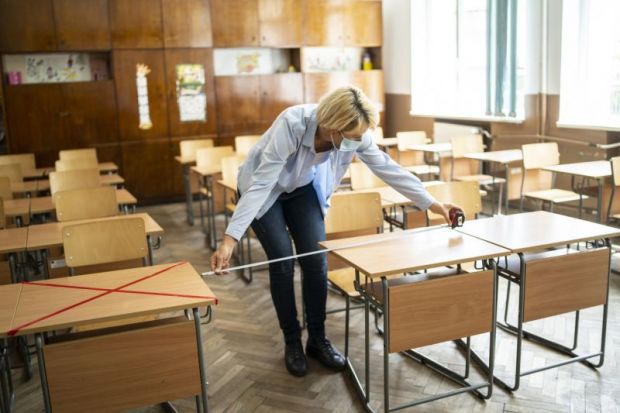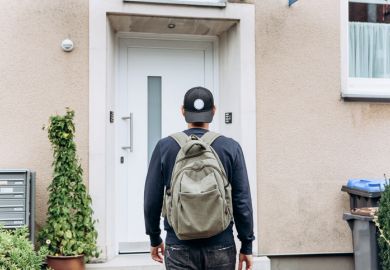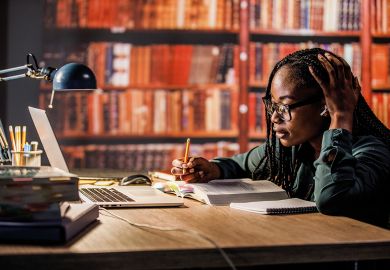“There are issues with hearing, with seeing, with the energy in the room. These are seminars, not lectures; we would normally be gathered around a table talking, but instead chairs are lined up 1 to 1.5 metres apart with students wearing masks and me at the front wearing a mask and a visor. You feel really cut off.”
Welcome to the world of teaching in the time of coronavirus. Speaking to Times Higher Education, a number of academics emphasised how keen they had been to get back to face-to-face teaching, but also how dramatically the learning environment has changed.
Samantha Walton, reader in modern literature at Bath Spa University, explained that returning to campus with the new rules and safety measures “feels like learning to teach all over again”.
“For my subject, the magic of teaching really comes from learning and talking together, it’s not a discipline that works well just lecturing people,” she said. “The whole sense of being an expert is out the window because you are really trying things out every time you enter a room. There’s a sense that it might not be as good as it could be, which is frustrating because you want the best every time.”
She added that there is a “real weirdness” to teaching in protective gear. “My admiration for health workers wearing serious PPE is huge. I’m wearing glasses, a cloth face mask, then a visor. It really screws your vision, hearing and your perception of space…It feels like you’re working from a pod, it does change the teaching dynamic,” Dr Walton said.
But she added that the students seem to really want to be in the room. “One of my colleagues was saying he had one of the best seminars for ages, because they are all excited to be there,” she said.
There are also a lot of competing demands, Dr Walton explained, such as anxiety from students about coming in as well as accessibility for students who are deaf or use lip reading, so neither online nor in person works for them. “There is no perfect way to do this because there is nothing that works for everyone,” she said. Although one positive was that it means teachers are really thinking “on a fine-grain scale about what the experience is like for everyone”.
Another academic at an English university explained that “even with considerable prep the [first] session caught me off guard”. A 300-person capacity lecture theatre had been repurposed for a 25-person seminar. “The cohort streamed into the lecture theatre in total silence, all masked up except for one student who has COPD. Marked-out seating places meant they were then sitting almost one student to a row of 10 seats, meaning even paired work was virtually impossible,” they said. “The lighting caused glare off my visor, giving the whole experience a surreal and ‘dreamlike’ quality. I couldn’t read the students’ expressions – were they with me or not? They tried to answer questions I posed, but it was hard to hear most of their answers without asking them to continually repeat themselves.”
They explained that all their colleagues had felt their classes “had fallen flat”, causing them to question their “confidence and competence as educators”.
“I want to teach in person, but not like this. Bringing students into lecture theatres for classes, with all the risks that generates, when the educational encounter is this bizarre and then asking them to communicate with one another online during those classes seems like doublespeak,” they said.
Not everyone had such a disheartening experience. Katharine Adeney, director of the University of Nottingham Asia Research Institute, said that she was “quite anxious” before but has been “pleasantly surprised” about how well it has gone. “It felt a bit weird at first but as the class progressed, I forgot about the visor. Everyone in my classes contributed to the discussion and the masks didn’t get in the way at all, from my perspective.”
She said she had been shocked by how many students have had to self-isolate as a result of virus outbreaks on campus, but they had set up online seminars. “I’ve been very annoyed by statements about universities being closed or students not receiving proper tuition,” Professor Adeney said. “My colleagues and I have been working very hard over the summer to ensure that there are high-quality online materials – not just watching a 50-minute recorded lecture – for the students to engage with in addition to their face-to-face teaching. The pedagogical reflection that has gone into the creation of these materials has been extraordinary.”
Register to continue
Why register?
- Registration is free and only takes a moment
- Once registered, you can read 3 articles a month
- Sign up for our newsletter
Subscribe
Or subscribe for unlimited access to:
- Unlimited access to news, views, insights & reviews
- Digital editions
- Digital access to THE’s university and college rankings analysis
Already registered or a current subscriber? Login








